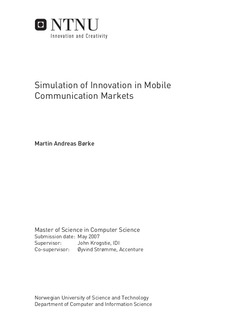Simulation of Innovation in Mobile Communication Markets
Master thesis
Permanent lenke
http://hdl.handle.net/11250/250432Utgivelsesdato
2007Metadata
Vis full innførselSamlinger
Sammendrag
Mobile communication markets are known for frequent innovations with potentially high network effects. The conceptual work in economics and innovation studies show how the growth pattern for innovations in such markets could vary depending on the competition and market characteristics. However, the empirical research within this field is limited. This thesis introduces a computer simulation model for analyzing the development, adoption and diffusion of innovations in a mobile market. The model is based on Agent-Based Computational Economics (ACE), and makes use of behavioral theory of firms, economics, and sociology, to leverage the theoretical understating of the diffusion of innovations. The results of the simulation runs on the developed simulation software show that the topologies of social networks have strong effects on diffusion. However, it is also found that in situations where several competing companies launch their innovations sequentially, a winner-takes-all outcome is the most likely when the actors are completely rational. Further, when the information in the market is imperfect, the topology of social networks can create equilibria where the market is shared between several providers. Finally, the variance in consumer characteristics affects both the rate and the outcome of innovation diffusion. The thesis reaffirms that computer simulation is an effective way to combine the sociological and economic theories of innovation diffusion. The results show that there is still a need for more research on the field to better understand why some innovations fail, while other succeed and becomes accepted in the market. The outcome of an innovation launch is shown to be affected by several factors, including timing, network structure, market noise, and consumer characteristics. By using the simulation model to study the influence of such factors in a specific market, service providers may improve their competitive power.
